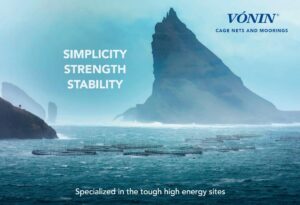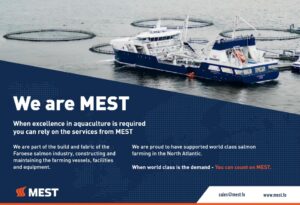Fjords, the Faroes and flying fish
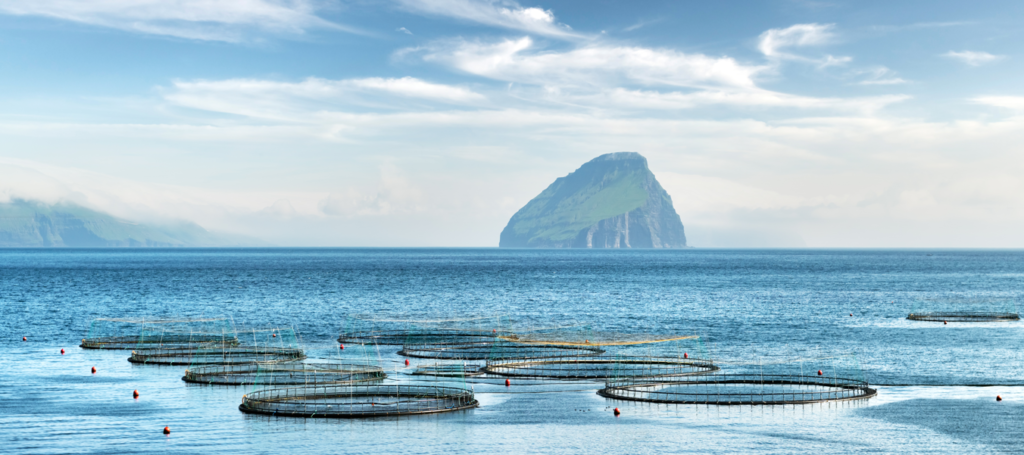
For a small fish farming nation, this rocky archipelago punches above its weight, writes Robert Outram. Additional reporting: Vince McDonagh
The Faroese Research establishment formerly known as Fiskaaling has a new name: Firum. To understand why, a brief lesson in the Faroese language is required. As Chief Executive Jóhanna Lava Køtlum explains, “fiskaaling” translates as “fish farming” and this gives the false impression that the organisation is farming fish – something it has not done, even at a small scale, for a number of years now.
“Firum” combines the Faroes words for “fjords” and “environment”, and better sums up the organisation’s research brief.
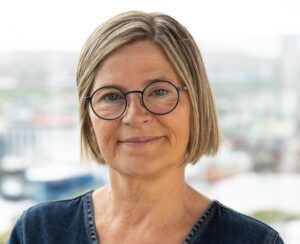
Jóhanna Lava Køtlum
Køtlum says: “The fjords are the reason we have such a healthy aquaculture sector in the Faroe Islands – and the environment is crucial also for the health of fish and other farmed organisms, which are farmed in the sea or on land-based stations.”
One focus is the general state of the fjords and the open seas around the Faroes. To help understand this, Firum has been investing in computer capacity to support an increasing demand for modelling and for processing an ever-growing amount of data. Methods such as eDNA (environmental DNA) analysis help to create a fuller picture of marine life in the environment.
“Also,” says Køtlum, “We are modelling particles from aquaculture activity to see how the particulate footprint from fish farms affects the fjords.”
While there are no wild salmon in the rivers and streams of the Faroe Islands, there are wild sea trout. Protecting them is a priority.
In common with their neighbours in Norway and Scotland, Faroese fish farmers are also encountering challenges from microalgae blooms and jellyfish, whether of the micro variety or the larger string jellyfish.
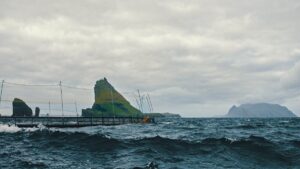
Faroes farm
Køtlum says: “It’s important to monitor this and to see whether it is becoming more of a problem, and whether it is connected with climate change.”
She adds: “The traditional way of keeping an eye on the farmed fish was focused on disease management. At Firum, we are more focused on welfare, because this will give the industry a good indication of the general well-being of the fish. There are a lot of things that can affect the welfare of the salmon – it could be physical handling of the fish, delousing, microalgae or jellyfish, bad weather or whatever. Stressed fish, or fish with a lot of sea lice in their environment, can be vulnerable to disease outbreaks.”
One practical way that Firum has been able to assist is through the development of a planning tool to help predict the likely growth of sea lice. Based on the conditions, timing and the number of fish, the tool can help to indicate which sea lice populations are likely to develop on the fish until they are slaughtered. It can also indicate the requirement and best timing for treatment.
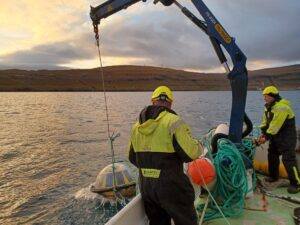
Firum team retrieving a wave and current buoy from Kaldbaksfjord
Køtlum explains: “With good planning, we have found that the companies could use fewer treatments when the fish are in sea cages. Mechanical treatments can be tough for the fish and we’d prefer the chemical treatments to be used as little as possible.”
One of the PhD projects at Firum focuses on salmon heart health, comparing the typical shape of a wild salmon heart with that of its farmed counterpart. As Køtlum puts it: “It’s like humans: if we have a stressful life, it can create problems with our heart.”
One lesson that is already becoming clear is that focusing on fast smolt growth at all costs is not the way to good fish health. In fact, it appears that slower, steady growth in freshwater can create the conditions for healthy fish that will grow faster once in the sea.
The Faroese farmers have also been applying a strategy of growing the salmon smolts for longer before they make the transition to the sea. Previously a farmed salmon might spend one-third of its life in freshwater and two-thirds in sea cages – now those ratios are typically reversed.
And it is not only the salmon whose welfare matters. Firum is also researching the factors important to lumpfish welfare. Lumpfish play an important role as cleaner fish in salmon pens. Understanding their needs will help to ensure they are handled ethically.
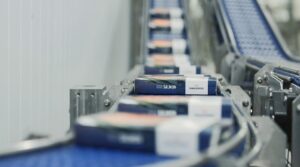
Bakkafrost value-added products
Farming challenges
The Faroes is a significant producer of salmon, with three main players: the stock exchange-listed Bakkafrost, family-owned Hiddenfjord and Mowi’s Faroes arm.
As a listed company, Bakkafrost is not only the biggest of the three, but also provides the most detail on its operations. In its trading update for Q4 2023, Bakkafrost reported that after a difficult time with biological challenges between July and September: “The fourth quarter gave opportunities with good biological development to grow the fish, resulting therefore in reduced harvest volumes, concentrating on growing into the first half of 2024 to larger sizes.”
The Bakkafrost group recorded Q4 revenues of 1,562m Danish kroner (£179.5m) against DKK (£223m) in the corresponding period in 2022. The operational EBIT was DKK 356m (£41m) during the period against DKK 376m (£43m) 12 months earlier.
The group’s interim report for 2023 shows that Bakkafrost recorded DKK 7,141m (£819m) in revenue, up around 15% on 2022’s total. Group operational EBIT was, however, down 9% to DKK 1,544m (£177m). Financial profit for the period was DKK 955m (£110m), down around 29% year-on-year. The audited annual report and accounts are due to be published on 27 March.
Commenting on the results, CEO Regin Jacobsen said: “I am proud of the progress, from the high focus on fish health and welfare in the Bakkafrost’s operation in the Faroe Islands, which have resulted in a robust and strong farming regime.
“The average monthly survivability for the full year was 99.39%, with an average harvest weight of 4.6kg HOG and 90% superior grade.”
In the Faroes, Bakkafrost has continued to invest in its “large smolt” strategy, growing its fish for longer in freshwater. As part of this, the Norðtoftir, Glyvradal and Viðareiði hatcheries have been expanded, with a capacity increase of more than 50%.
In Q4 2023, Bakkafrost signed a contract to build a big new hatchery in Skálavík, Faroe IsIands, which will increase the production capacity by around seven million smolt at 500g. The construction will begin in Q1 2024. When it is finished in the next three years, the group’s annual smolt production capacity in the Faroe Islands will be 24 million smolts at 500g.
The company has made cutbacks in its value-added processing segment, however. In November, Bakkafrost laid off 140 processing staff, blaming the islands’ new tax regime for fish farming which, the company said, meant it had to cut back its long-term contracts with customers.
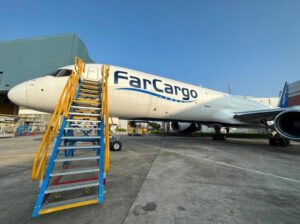
Bakkafrost’s FarCargo air freight service
Should fish fly or swim?
Meanwhile another area in which the company has been investing is airfreight, with its subsidiary FarCargo about to start weekly flights between Denmark, the Faroes and the USA, as reported in this issue.
Bakkafrost argues that the new service will mean a better deal, not just for salmon exports but for trade generally between North America and northern Europe. Its local competitor, Hiddenfjord, takes a different view, however.
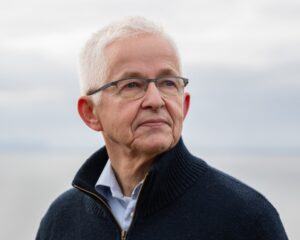
Atli Gregersen
In October, Hiddenfjord marked three years since it abandoned air freight for its exports, saving what it says is around 200,000 tonnes of CO2 emissions.
Instead, Hiddenfjord has developed a sea freight alternative with a freezing technique that, it argues, preserves quality, taste and texture on the sea voyage via Iceland to the US east coast.
Atli Gregersen, Hiddenfjord’s CEO, said on the anniversary: “Transporting food by air is simply unethical. Full stop.”
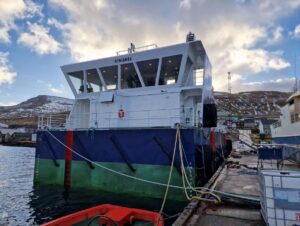
MEST feed barge
Supply chain stars
As a centre of aquaculture with a centuries-long traditional of maritime expertise, the Faroe Islands are home to a number of well-regarded businesses serving the fishing and aquaculture sectors.
Recent projects for MEST Shipyard, for example, have included the delivery of the first of two catamaran workboats for Hiddenfjord and the complete overhaul of a feed barge that sank off Iceland.
The workboat Heldarsgjógv was delivered to the customer on 22 November. All the work has been done in the Faroe Islands – including the hull.
Mouritz Mohr, MEST CEO, said: “Because all the work is undertaken at MEST facilities – design, drawings, the hull, the electrical installations and everything else – we can ensure a good quality of the final product.”
The new catamaran, which is new build 116 at MEST, is 16m long and 8m wide. It is fitted with two Volvo Penta 500 HK engines, two MELCAL cranes (one FL 80T5 and one FL23T2 crane), a Volvo Penta 250kWa generator and a 20-tonne hydraulic winch. The workboat is equipped with a net washer from Akva Group – which enables the staff to clean the salmon nets.
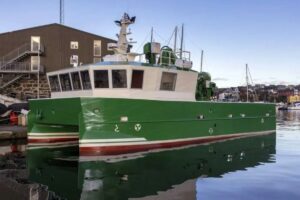
MEST Catamaran workboat
Meanwhile, the feed barge Muninn, which had sunk in bad weather and had to be towed from Iceland, has been renamed Sýnisnes and is now operated by Bakkafrost. The refit of the feeder system was undertaken by GroAqua.
Faroese businesses are also not averse to looking beyond the islands when it comes to investment opportunities. In January Vónin, which makes nets, moorings and other equipment for trawlers and aquaculture operators, acquired the Scottish subsidiary of Norwegian competitor Mørenot.
Hjalmar Petersen, CEO of Vónin, commented: “This takeover marks a landmark moment in our history. We have steadily grown our presence in Scotland, emerging as a key supplier in the local aquaculture industry.
“With Vónin Scotland, we’re not just consolidating our position but also gearing up to bring even more innovation and excellence to the market.”

